[Editor’s Note: Combat veteran and amateur military historian Charles Herrick’s crucial earlier posts in this series corrected 70 years’ worth of miscaptioning of one of Robert Capa’s ten D-Day photographs from Omaha Beach, and pinpointed the exact location and approximate time at which he landed on the Easy Red sector with a later wave.
In this new article, Herrick considers a sampling of what he calls “parasitic legends” that have built on and attached themselves to the primary Capa D-Day myths as seeded and expanded upon by Capa, John Morris, and others.
Somewhere along the line during the course of this investigation I coined the term “borrowed glamour” — intended as a milder corollary of the more familiar “stolen valor” — to describe the less objectionable but still problematic tendency to exaggerate or invent entirely one’s relationship to celebrated individuals, historical moments, etc. Herrick has adopted that as the title for this series of posts.
Part 3 appears below; click here for Part 1, and here for Part 2. — A. D. C.]
•
Borrowed Glamour (conclusion)
by Charles Herrick
•
William Kays and the LCVP
One of the curious aspects of the Capa D-Day myth is that no one remembered riding to the beach with him. Being in the same landing craft with a LIFE photojournalist is normally the kind of detail that most men would note and remember for years to come. But not Capa. Three men of LCI(L)-94 mentioned him returning from the beach with them, but none for the run in.
This gap seemed to be filled when William M. Kays published his book Letters From A Soldier: A Memoir of World War II, in 2010. Originally put into manuscript form in 1994, it was largely based on 123 letters that Kays wrote to his family back home, so the manuscript appeared to have a much firmer factual foundation than most memoirs written 50 or more years after the fact.
•
Kays was the commander of a provisional engineer company consisting of two platoons attached to the 1st Battalion, 16th Infantry. Those two platoons came in on three LCVPs in Wave 11, the same wave as Company B of that battalion. Also in that wave was the LCVP carrying the 1st Battalion’s commander, and Kays claimed to have ridden in on that boat.
He also claimed to have stood next to Capa at the rear of that landing craft and chatted with him. After exiting the landing craft, Kays wrote, he made his way to the shelter of a tank, and spotted Capa behind another tank 20 or 30 yards to the left. As in Charles Hangsterfer’s account (see Part 2 of this series), Capa purportedly aimed his camera at Kays and took a picture that included his face, but apparently it was one of the pictures supposedly lost in what we know now was a fictional darkroom accident.
•
Kays’s account has much going for it. Unlike most “borrowed glamour” stories, Kays’s version puts him on the correct ship, the USS Samuel Chase. Unlike most, he didn’t alter his story to fit the commonly held fiction that Capa came in with Company E in the first wave. Unlike most, he placed their landing at the correct location on Easy Red. And, again unlike most, he was generally correct on his beaching time, resisting the near-universal tendency in oral histories to move times closer to H-Hour (though his figures show a bit of confusion on that point).
But the credibility of Kays’s account falls apart under close examination. While much of his book is based on contemporary letters to his family, the bulk of the text consists of reminiscences, which are subject to the same memory issues as other personal histories recorded decades after the fact.
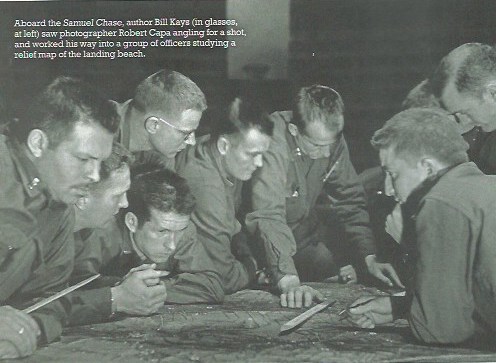
Robert Capa, USS Samuel Chase, June 4-5, 1944, officers look over relief map of Normandy coast (detail). As published in William Kays article, World War II magazine, June 2019.
For instance, the night before the invasion, Kays recalled, he went down to the Chase‘s hold to study the relief map of the invasion area, and there “I noticed a well-known news photographer, Robert Capa of Life Magazine.” The problem here is that, outside the relatively small circles of journalists and photojournalists, Capa was not really “well-known” at that point in his career. He certainly wasn’t the sort of popular-culture icon who would get recognized on sight by the average man in the street (or troopship, for that matter). Among members of the general public, his celebrity status came posthumously, starting in the early 1960s. As a result, Kays’s narrative at this point does not have the ring of contemporary authenticity.
[Editor’s note: Capa was not the only photographer aboard the Chase on the crossing. Herman V. Wall, U.S. Army Commanding Officer of the 165th Signal Photo Company, sailed on the same ship, along with members of his team. So did U.S. Coast Guard photographer Robert Sargent. Certainly someone could have photographed Kays looking at the relief map — if that’s really him in the photo. I leave the reader to judge whether the figure he identifies as himself in the Capa image reproduced here resembles Kays in the 1945 image at right. — A.D.C.]
•
Kays’s first letter after D-Day was not written until eight days later. That letter made absolutely no mention of encountering Capa on the landing craft. Nor did it alert his folks that Capa took his picture at the relief map or in the surf. Kays took the time to complain about his food and mention the local dairy cattle, so it is even more curious that he didn’t mention his own potential appearance in national media.
Those omissions might have been understandable had the letter been written within a day of the landings, when the relief of survival was immediate and overwhelming. Eight days later, however, it defies belief that he would not have alerted his family to look for photos of him in the press — if indeed he had encountered Capa as he claimed.
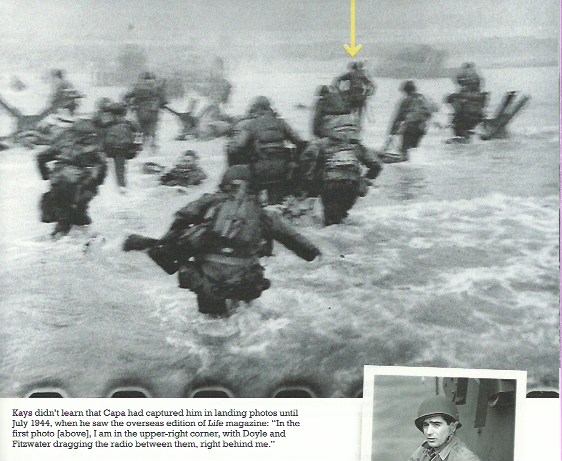
Robert Capa, CS frame 1, neg. 29 (detail), as annotated and captioned by William Kays. World War II magazine, June 2019, p. 51.
It was not until Kays’s letter of 25 June that Capa’s presence was finally mentioned, and it was again dropped in such a casual manner that it implied Capa’s was an instantly recognizable household name. Which it was not at that point of his career. That letter stated, “Life photographer Robert Capa was next to me in the boat …” “Life photographer Robert Capa” … that’s very awkward phrasing for a letter home, sounding more as if the phrase was crafted later to take advantage Capa’s subsequent renown. It would have sounded much more natural if Kays had simply said “a photographer from Life was next to me in the boat,” omitting the name, since Capa’s name recognition was not really widespread at that point.
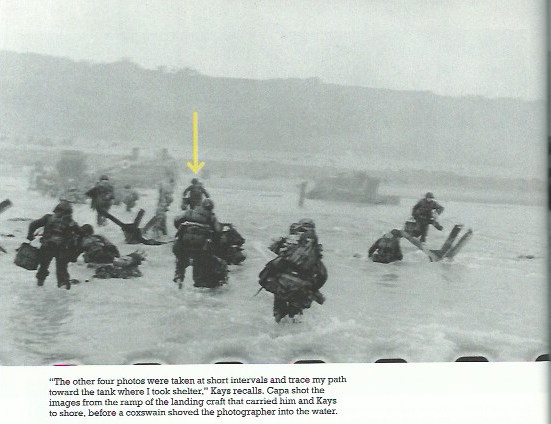
Robert Capa, CS frame 2, neg. 30 (detail), as annotated and captioned by William Kays. World War II magazine, June 2019, p. 52.
Again, it just does not have the ring of authenticity for a letter written in June 1944. Kays’s phrasing sounds more like a description someone would use when recalling long-past events involving a person who has since become famous. And, in fact, those are precisely the words Kays used to describe Capa again, some 40 pages earlier in another passage of reminiscences dating from the 1990s: “I found myself standing next to the Life photographer, Robert Capa, who had taken my picture the night before.”
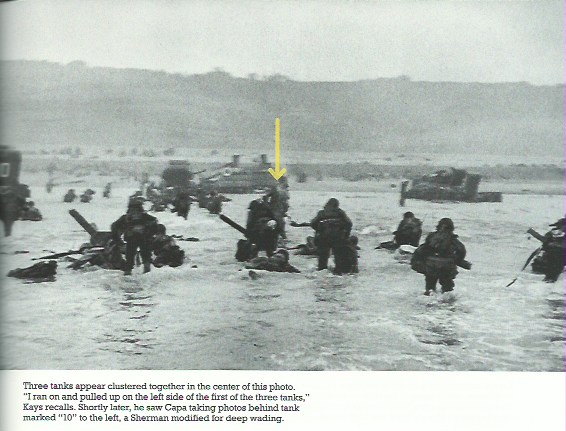
Robert Capa, CS frame 3, neg. 31 (detail), as annotated and captioned by William Kays. World War II magazine, June 2019, p. 53.
•
Beyond this, Kays’s description of his movements and the tanks’ locations do not match Capa’s photos. Using Kays’s own identification of himself in Capa’s photos, he moved directly from his landing craft to the tank indicated by the red arrow in the following two photos. At that position he claimed he looked to the left and saw Capa sheltering behind another tank 20 or 30 yards away, which, in his book, he identified as tank no. 10. There is no tank in that location — at least not when Capa landed and took his pictures — and tank dozer 10 was actually far to Kays’s rear.
The tanks were undoubtedly in different positions when Kays landed at 0750 hours, and at that time there may have been a tank 20-30 yards to the left of whichever tank Kays sheltered behind. But the tanks were not so positioned when Capa landed, which proves he did not land with Kays.
Furthermore, Capa stopped first to shelter behind a “hedgehog” obstacle for an undetermined period of time, then moved to the shelter of tank dozer 10. Assuming Kays landed at this time, he had headed directly to his tank at the waterline. But Capa would have been far behind and sheltering on the back side of his tank dozer. The idea that Kays could see Capa taking pictures in this physical arrangement is not credible.
But the final disproof of his assertion lies in Capa’s photos. Coast Guard Chief Photographer’s Mate Robert Sargent rode in on a Chase landing craft that dropped off Company A of the 1st Battalion at 0740 hours. Records confirm that Kays’s boat beached just 10 minutes later, and, if we believe Kays’s account, it was then that Capa took his photos. But by comparing the water levels in Sargent’s and Capa’s photos, along with the beach profiles and tide charts, it’s apparent the tide has risen 3-4 feet between the two sets of photos. With the tide rising about one foot every eleven minutes, Capa’s photos must have been taken somewhere between a half-hour and forty-five minutes after Sargent’s. This definitively disproves Kays’s assertion that Capa rode in on the same landing craft with him and the commander of the 1st Battalion.
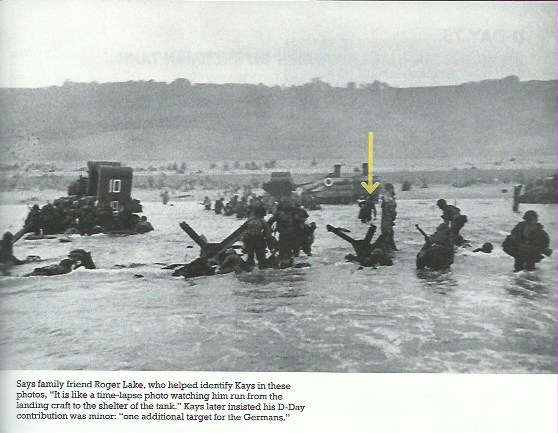
Robert Capa, CS frame 5, neg. 33 (detail), as annotated and captioned by William Kays. World War II magazine, June 2019, p. 55.
And lastly, Kays’s identification of himself in Capa’s debarkation photos is even more imprecise than the identification of Huston Riley in “The Face in the Surf.” At least we can see the soldier’s blurry face in Riley’s case; we cannot even say that much for Kays. Furthermore, while Kays stated he was at the back of the landing craft, the figure he identified as himself was ahead of fully a third of the LCVP’s load of troops after only a few yards in the surf. Quite simply, Kays’s narrative does not match Capa’s photos.
So it is that our one potential eyewitness to Capa’s arrival on Easy Red proves not to be reliable.
•
While it may appear at first glance that we have numerous independent accounts of Capa on D-Day, it is important to realize that few latter-day accounts are entirely reliable. Memories fade and the gaps are often filled with what we would like to remember rather than what did happen. Each account must be carefully evaluated before being accepted, and it is the failure to do so that had led to so much confusion and error in reconstructing Capa’s D-Day adventures.
•
[Editor’s note: Herrick undertook this series when I forwarded to him a pdf file of an article by Kays — an edited excerpt from his 2010 book — published posthumously in the June 2019 issue of World War II magazine, Vol. 34, no. 1. (The magazine indicates that it is “Endorsed by the National World War II Museum, Inc.” and published by HistoryNet LLC, connected to the website HistoryNet.com.)
Kays’s article, which occupies pp. 48-55 of that issue, also appears at the magazine’s website, titled “I Stormed Ashore With Robert Capa on D-Day.” In both versions it comes accompanied by a letter of endorsement from John C. McManus, author of The Dead and Those About to Die: D-Day, The Big Red One at Omaha Beach (2014), a book in which McManus erroneously places Capa with the second wave to arrive on Easy Red. On the magazine’s interior the article bears the title “Going Over the Top.” On the cover, however, it’s “I Stormed Ashore with Robert Capa.”
Kays’s book reproduces just two of Capa’s sequence of five images. I have illustrated this section of Herrick’s article with scans from the magazine layout, which includes the full sequence, and in which yellow arrows point to one soldier.
Kays, who died in September 2018 at the age of 98, appears from his obituary a thoughtful, rational adult. Exactly how he convinced himself that he was the tiny, blurry figure seen from behind that he indicates in Capa’s pictures I cannot imagine. And I have no explanation for the impulse behind this self-mythification. Save this, from the article (and probably also from the book):
“The Chase had a gymnasium down below, where a huge relief map of the entire invasion area had been set up. I had gone to take a look at it with some other 1st Battalion officers when I noticed Capa there, trying to take a picture of the officers examining the terrain, and I worked myself into the group.” (Pp. 50-51)
Hmmm. — A.D.C.)
•
Text copyright © 2019 by Charles Herrick. All rights reserved.
•
(For an index of links to all posts in this series, click here.)
•
This post supported in part by a donation from Rick Telberg of CPA Trendlines.
•
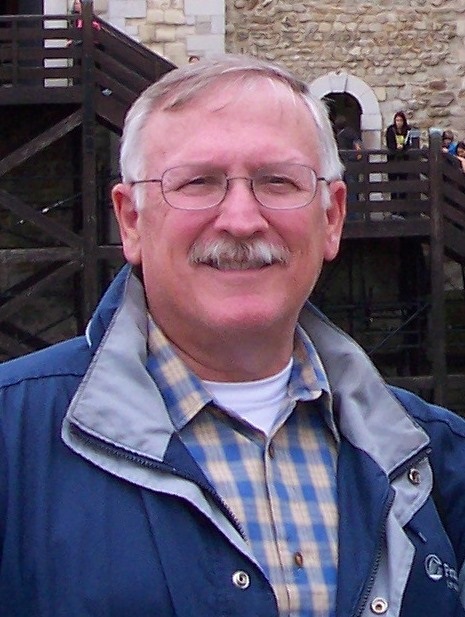 Charles Herrick joined the U.S. Army in 1970 and graduated from the U.S. Military Academy at West Point in 1974. Commissioned in the Infantry, he earned the Ranger tab and Master Parachutist’s wings. He served in a variety of positions from company grade officer to the Pentagon. He earned the Combat Infantryman’s badge while assigned as the Operations Officer of the 193rd Infantry Brigade in Panama in 1989, and later graduated from the U.S. Army War College.
Charles Herrick joined the U.S. Army in 1970 and graduated from the U.S. Military Academy at West Point in 1974. Commissioned in the Infantry, he earned the Ranger tab and Master Parachutist’s wings. He served in a variety of positions from company grade officer to the Pentagon. He earned the Combat Infantryman’s badge while assigned as the Operations Officer of the 193rd Infantry Brigade in Panama in 1989, and later graduated from the U.S. Army War College.
Since retiring from the Army in 1996, Herrick has continued to work on defense issues as a contractor in East Asia, Latin America, the Balkans, Africa and Central Asia. He holds an MBA from the University of California at Los Angeles. He lives in California with his wife, where he pursues his passion for military history. To contact Charles Herrick, click here.


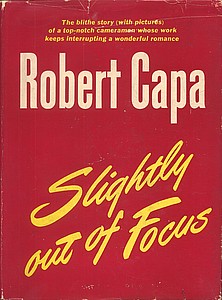
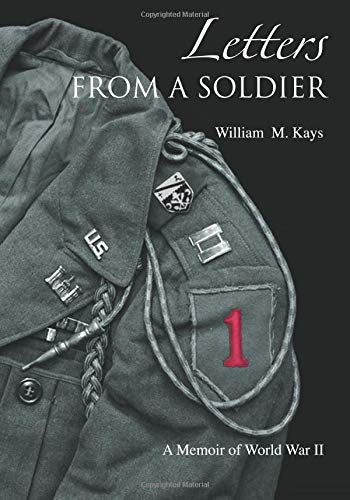
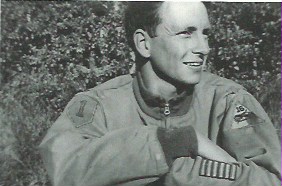
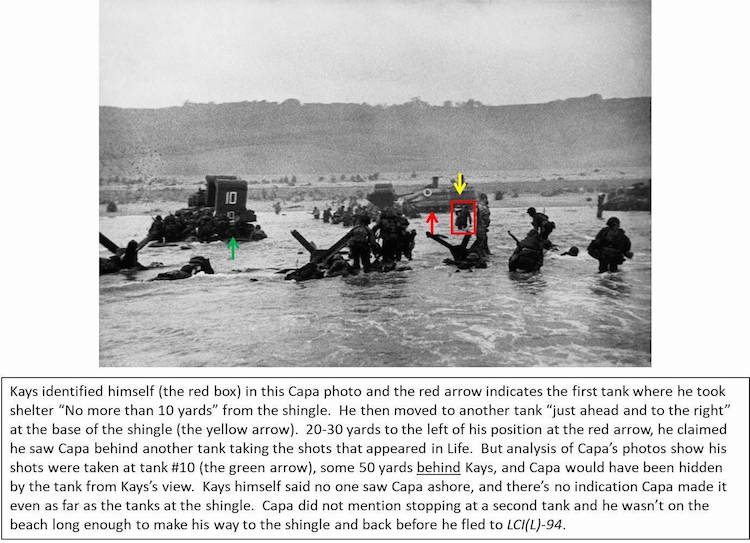
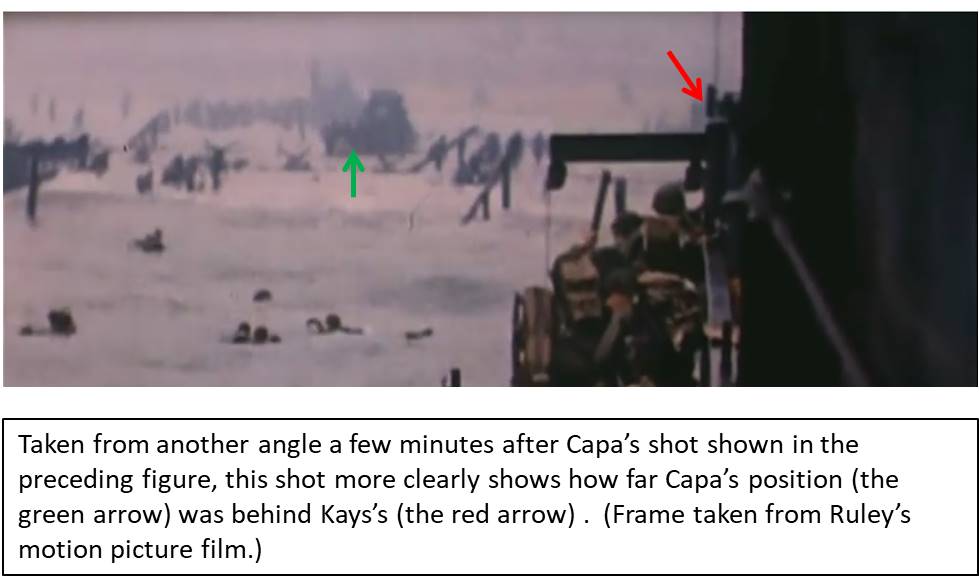
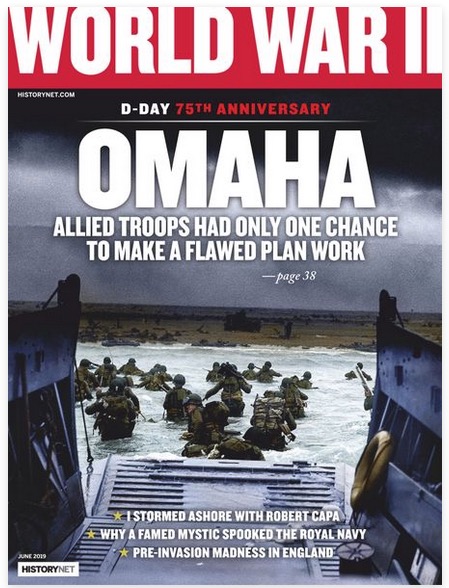
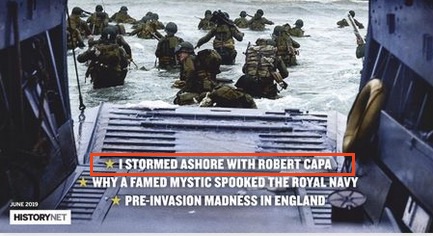




The photo online is not clear enough, but if there is a better version of the group shot, it should be quite easy to see if the subject is really Kays :https://www.medicaldaily.com/ears-better-fingerprints-id-234507.
There are better-quality versions of that image available in the Capa Archive at the International Center of Photography. Unfortunately, I don’t have access to digital files thereof.
However, the link you provide does not offer convincing testimony that ears can serve as reliable evidence of identity.
To my eyes, the figure just below the man on the left with glasses — the one with dark hair, resting his elbow on the table — resembles Kays somewhat more.
But whether Kays appears in that photo doesn’t really matter, because that wouldn’t in any way support his claim to recognize himself as the blurred, murky figure seen from the rear in the distance in Capa’s Omaha Beach photos.
I don’t understand how Herrick has worked out that the tide is higher in Capa’s photos. The length of shoreline is nearly identical and Sargent clearly took his photo from a higher angle. It is also entirely dependant on the terrain of the beach, aerial photos of the beach make it clear that the length of the beach is not uniform. Similarly, in Capa’s photos, the water reaches up to their knees. In Sargent’s the water is much higher. There are too many assumptions being made here.
Also, does this article imply that Kays forged the 25 June letter or am I reading it wrong?
Mr. Kerr,
Thank you for reading this post and your questions.
I think you may have confused the Sargent photo I referred to with the frame grab from Ruley’s film, which was right above the paragraph in which I mentioned Sargent. Ruley’s film was shot from the boat deck of LCI(L)-94, while peeking around the pilothouse. So, yes, that photo was taken from a higher vantage point. But it is NOT the Sargent photo I referred to.
Sargent’s photo is the one that graced the cover of the June 2019 WWII magazine. Here is the NARA image: https://catalog.archives.gov/id/195515
Capa and Sargent were at virtually the same height, both being in beached LCVPs. Although Capa was at the bow of his LCVP, and Sargent was forward near the coxswain’s station, their perspectives were virtually identical, so comparisons of distance to the shingle embankment are practical
As to the question of ‘forging’, of course not. I’ve never seen the original so could not possibly make such a judgement.
But it is worth noting that he made no mention of Capa being in his LCVP in his 14 June letter to his sister, and that would have been the logical time to alert his family that not only was he safe, but that his photos might be in in the papers or magazines. Capa doesn’t pop up in Kays’ letters until 19 days after D-Day (assuming the book faithfully transcribed the letters), by which time Capa’s coverage would be well known within the units due the Army’s public affairs network, and possibly due to the arrival of the “pony editions” (condensed versions of popular magazines printed for fast delivery to troops overseas) of LIFE as well. I suggest that many details that suddenly surfaced 19 days after D-Day were influenced by media coverage of the landings, which Kays may have incorporated into his own narrative.
A close reading of Kays’ various accounts of his landings (in his letters and the narrative of his book) discloses many errors, as well as admission that he wasn’t clear on many points. For instance, he claimed a large concrete blockhouse was 150 yards away from him when he was behind the tank, but there was such structure in that vicinity.So, while Kays’ book is a fascinating account from a soldier’s perspective, I would caution that details in such accounts are frequently influenced by many things, and details are not always to be considered entirely accurate.
Again, thank you for your comments.
My apologies. The second sentence of the second to last paragraph should have read: ” . . . but there was NO such structure in that vicinity.”